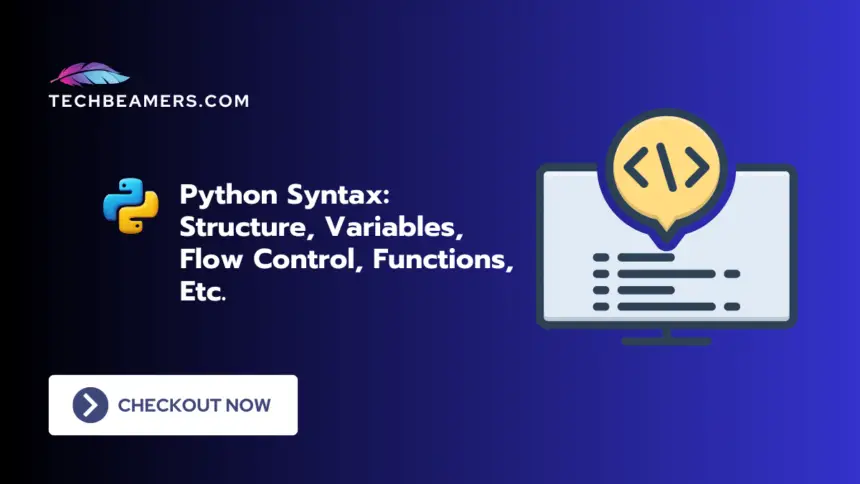Python, the language known for its simplicity and friendliness, has a way of writing code called syntax. It’s like the grammar of Python, telling you how to structure your code so the computer can understand and execute it. In this guide, we’re going to break down different parts of Python syntax, with clear explanations and plenty of examples to help you get the hang of it.
What is Python Syntax?
Python syntax is the set of rules governing how Python code is written. It defines the structure and organization of statements, variables, and functions, ensuring code clarity and readability. Understanding Python syntax is essential for writing effective and error-free programs in the language. Let’s consider a simple example of Python syntax:
# Example: Printing a Message
message = "Hello, Python!"
print(message)In this snippet, we assign a message to the variable message and then use the print statement to display it. This illustrates the basic structure and usage of Python syntax.
While learning any programming language, the first thing to learn is its syntax. The same thing is true for Python. Python syntax is simple and you can remember it easily. However, it has a lot of built-in constructs to ease up your coding tasks. So, it is important to understand their syntax variations. Hence, let’s start to understand the Python syntax.
1. Understanding How Python Code Works
Python code is like a story with a series of sentences. Each sentence does something specific. Unlike some other languages, Python uses spaces at the beginning of lines to organize related sentences, making it easy to read. Let’s check out a simple example:
# Example 1: Basic Python Code Structure
print("Hello, World!") # This prints a message
x = 5
if x > 0:
print("x is positive.")In this example, the print sentence shows a message, and the if sentence checks if x is greater than 0, printing another message if it is.
1.1 Indentation in Python
Indentation is super important in Python. While other languages use braces to group code, Python relies on indentation. It’s not just for looks; it tells Python where different parts of the code start and end. Like, if you have a loop or a function, Python knows it based on how indented the code is. Getting indentation wrong can mess up the code and cause errors. So, making sure your code is indented correctly is a big deal to write good Python programs.
Here’s an example that demonstrates the significance of indentation in Python syntax:
# Example: Using Indentation
def greet(name):
if len(name) > 0:
print(f"Hello, {name}!")
else:
print("Hello, stranger!")
# Calling the function with indentation
greet("Meenakshi Agarwal")In this example, the indentation within the greet function and the if-else block is crucial for determining the scope of each code segment. Incorrect indentation could lead to syntax errors or unintended behavior.
1.2 What is the standard indentation size in Python?
The typical and widely accepted indentation size in Python is four spaces. Even though some people might use two spaces or a different size, most folks stick with four. This consistency is vital for making code easy to read. When everyone uses the same size, it helps avoid confusion. Most code editors automatically set up four spaces for Python.
2. Getting to Know Variables and Data Types
In Python, you use variables to store information. You don’t have to say what kind of information it is; Python figures that out on its own. Let’s explore variables and types with everyday examples:
2.1 Python Variables / KeyWords
# Example 2.1: Naming and Storing Information
name = "John"
age = 25
height = 1.75
is_student = False
print(f"Name: {name}, Age: {age}, Height: {height}, Student: {is_student}")In this bit, name stores a name, age stores a number, height stores a height, and is_student stores whether someone is a student or not.
2.2 Python Data Types
# Example 2.2: Exploring Different Types of Data
num1 = 10
num2 = 3.14
text = "Python"
print(type(num1)) # This tells you the type of num1
print(type(num2)) # This tells you the type of num2
print(type(text)) # This tells you the type of textHere, we’re checking what kind of information num1, num2, and text are storing.
3. Python If, Else, and Loops Syntax
In Python, you can make decisions with if and else, and you can repeat actions with loops. Let’s go through these with real-world examples:
3.1 Making Decisions with Python If-Else
# Example 3.1: Making Grade Decisions
grade = 85
if grade >= 90:
print("A")
elif grade >= 80:
print("B")
elif grade >= 70:
print("C")
else:
print("F")In this story, we’re deciding what letter grade to give based on the value of grade.
3.2 Repeating Actions with Loops
3.2.1 Python ‘for’ Loop
# Example 3.2.1: Going Through a List of Fruits
fruits = ["apple", "banana", "orange"]
for fruit in fruits:
print(fruit)Here, we’re going through a list of fruits, like reading a list.
3.2.2 Python ‘while’ Loop
# Example 3.2.2: Repeating Until a Condition is Met
counter = 0
while counter < 5:
print(counter)
counter += 1In this case, we’re repeating an action until a condition is met, just like counting until we reach 5.
4. Writing Functions: Making Your Code Speak
Functions in Python are like recipes. You give them some ingredients, and they give you back a result. Let’s cook up a function with a simple example:
# Example 4: Cooking Up Greetings
def greet(name):
"""This function says hello to a person."""
print(f"Hello, {name}!")
# Using the function
greet("Harsh")
greet("Meenakshi")In this cooking adventure, our function greet takes a name and says hello. We even have a little note (docstring) describing what our function does.
5. Handling Errors: Python Exception Handling
In the real world, things don’t always go as planned. Python helps us deal with unexpected issues using try, except, else, and finally. Let’s handle errors like we handle bumps in the road:
# Example 5: Dealing with Unexpected Situations
try:
result = 10 / 0
except ZeroDivisionError:
print("Oops! Can't divide by zero.")
else:
print(f"Result: {result}")
finally:
print("This part always happens.")In this example, we’re trying to do something tricky, and if it goes wrong, we have a plan to handle it.
6. Creating Lists with Style: List Comprehensions
Python allows us to create lists in a cool way called list comprehensions. It’s like a shortcut for making lists. Let’s create a list in a stylish way:
# Example 6: Stylish List Creation
numbers = [1, 11, 111, 1111, 11111]
sqr_nums = [num ** 2 for num in numbers]
print(sqr_nums)In this stylish move, we’re squaring each number in the list with a single line of code.
7. Using Modules and Libraries
Python is like a superhero with a utility belt full of tools. We can use these tools by bringing in modules. Let’s grab a tool from the Python toolbox:
# Example 7: Using a Toolbox - the 'math' Module
import math
radius = 5
area = math.pi * radius ** 2
print(f"Area of the circle: {area}")Here, we’re using the math tool to do some calculations. Think of it like borrowing a calculator for a specific job.
Wrapping Up: Grasping Python Syntax
Navigating through Python syntax is like learning the alphabet of a language. In this short tutorial, we covered the basics—from code structure and variables to decision-making, repeating actions, crafting functions, handling errors, creating lists stylishly, and using powerful tools from Python’s toolbox. As you begin your Python journey, let these principles be on your tips.
Happy coding with Python!









